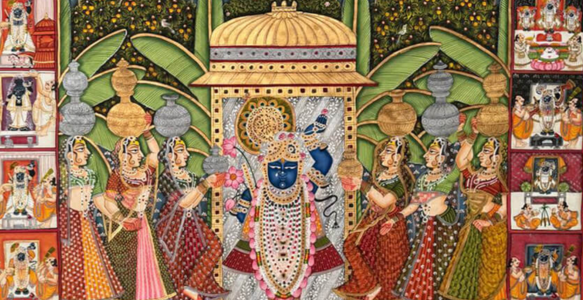What is Pichwai Painting?
Pichwai paintings are traditional Indian paintings born in Nathdwara, a part of the state of Rajasthan. They are intricate in detail and varicolored, usually depicting scenes from Lord Krishna's life, mostly about his incarnation as Shrinathji. Generally of a large scale, they are created to be placed at the back of deities in temples, adding to the spiritual ambiance.Historical Roots of Pichwai
Pichwai painting was established in Nathdwara over 400 years ago. Tradition has it, that it was the local rulers and temple priests who first initiated the tradition to develop a visual storyline of the life of Shrinathji. Over time this temple art flourished into a full-fledgedly important part of the temple rituals and festivities.Distinctive Features of Pichwai
What sets Pichwai paintings apart is their detailed complexity and vibrantly colored palette. Natural colors, stemming from minerals, vegetables, and precious stones, are used. Mostly, the themes revolve around the different seasons, festivals, and rituals associated with Shrinathji. The paintings are very symbolic, with a lot of lotus, peacocks, cows, and so on—all of them symbolize very basic important elements.The Role of Pichwai in Cultural Conservation
Preserving Religious Traditions
Pichwai paintings hold immense importance in sustaining the traditions of a religion. Most of the paintings are scene narrations usually depicting the life and legends of Lord Krishna, particularly focusing on Shrinathji. These kinds of visual narrations keep these stories alive so that the devotees can become more affiliated with their faith. On and off, the Shrinathji Pichwai paintings change with the season or occasion, and this shows the ever-changing and enthusiastic behavior of the cultural practices.
Sustaining Artistic Techniques
The art of Pichwai painting lies in the traditional techniques for preparing the canvas, mixing natural colors, and the intricate details in brushwork. Therefore, when artists practice these methods, not only is the art form but traditional knowledge and skills are preserved.
Empowering Artisans
Pichwai painting is the means of many livelihoods, not only in Nathdwara but elsewhere. In sustaining this art, we will then be providing a livelihood to all those associated with it, and in the process, looking after the skills of the artisans and the cultural heritage they bring forth. This kind of action is essential for the socio-economic fabric and its maintenance within the artisan community in an empowered mode.
The Modern Revival of Pichwai
Integration with Contemporary Art
Recently, the revival in interest for art in Pichwai has taken place through the use and integration of elements of Pichwai in Modern works of artworks and products designed by contemporary artists and designers. Traditional and modern styles thus merged to create a new look for Pichwai, which seemed to globally take on a new appeal.
Exhibitions and Art Galleries
Today, Pichwai paintings are a part of many innumerable exhibitions and art galleries all over the world. Such platforms bring visibility to the art and the artist, hence preserving and promoting Pichwai all over the world. Exhibitions also interpret the cultural and religious associations of the paintings with the audience, evoking an appreciation toward this heritage.
Digital Platforms
The digital age opened up new avenues for the promotion and preservation of Pichwai art. Social media, online galleries, and e-commerce portals have made it easier for artists to reach out to a global audience. Digital tools aid in the documentation and archiving of traditional techniques and artworks so that these are preserved for posterity.
How You Can Support Pichwai Art?
So, how can you support this beautiful art form? Here are a few ways:- Purchase Authentic Art: Buy Pichwai paintings from authentic sources so that the amount you pay directly supports the artisans.
- Attend Exhibitions: Visit exhibitions and galleries where Pichwai art is displayed. Your presence and interest can make a significant impact.
- Spread the Word: Share information about Pichwai art on social media and within your community. Public awareness is the first step towards preservation.
- Support NGOs: Contribute to organizations that work to promote and preserve traditional arts and crafts.
- Learn and Teach: Educate yourself about Pichwai art and its significance. If you’re a teacher, introduce this art form to your students to inspire a new generation of art lovers.
